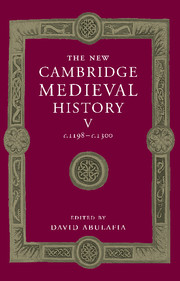Book contents
- Frontmatter
- Introduction
- Part I Common Themes
- Part II The Church in the Thirteenth Century
- Part III The Western Kingdoms
- 11 The Capetians from the death of Philip II to Philip IV
- 12 The Plantagenet kings
- 13 The kingdom of Burgundy, the lands of the house of Savoy and adjacent territories
- 14 Germany and Flanders
- Part IV Italy
- Part V The Mediterranean Frontiers
- Part VI The Northern and Eastern Frontiers
- Appendix Genealogical tables
- Primary sources and secondary works arranged by chapter
- Index
- Plate section
- Map 1 Europe in the thirteenth century
- Map 3 France, c. 1260
- Map 5 Germany and the western empire
- Map 6 Genoa, Venice and the Mediterranean
- Map 8 The Latin empire of Constantinople and its neighbours
- Map 10 Aragon and Anjouin the Mediterranean">
- References
13 - The kingdom of Burgundy, the lands of the house of Savoy and adjacent territories
from Part III - The Western Kingdoms
Published online by Cambridge University Press: 28 March 2008
- Frontmatter
- Introduction
- Part I Common Themes
- Part II The Church in the Thirteenth Century
- Part III The Western Kingdoms
- 11 The Capetians from the death of Philip II to Philip IV
- 12 The Plantagenet kings
- 13 The kingdom of Burgundy, the lands of the house of Savoy and adjacent territories
- 14 Germany and Flanders
- Part IV Italy
- Part V The Mediterranean Frontiers
- Part VI The Northern and Eastern Frontiers
- Appendix Genealogical tables
- Primary sources and secondary works arranged by chapter
- Index
- Plate section
- Map 1 Europe in the thirteenth century
- Map 3 France, c. 1260
- Map 5 Germany and the western empire
- Map 6 Genoa, Venice and the Mediterranean
- Map 8 The Latin empire of Constantinople and its neighbours
- Map 10 Aragon and Anjouin the Mediterranean">
- References
Summary
THE ‘middle kingdom’ created by the Treaty of Verdun in 843 for Charlemagne’s eldest grandson, Lothar, underwent many transformations in the course of the centuries, and by the thirteenth century it was known by many names, none of which made entirely clear what territories were included. Geographically, the region in question is bounded on the west by the valleys of the Rhone and Saône rivers, on the north and north-east by Lorraine and Switzerland, on the east by Lombardy and the Maritime Alps, and on the south by the Mediterranean sea. This part of the medieval Holy Roman Empire had traditionally been known as the ‘kingdom of Burgundy’, but by the thirteenth century it had become increasingly common to apply the term ‘Burgundy’ only to the northern part, and to refer to the regions from the Viennois southward as the ‘kingdom of Arles’, the ‘kingdom of Arles and Vienne’, or even as the ‘kingdom of Provence’. In 1193, for example, Emperor Henry VI sought to soften the impact of the ransom imposed upon Richard Lionheart by proposing to crown him ‘king of Provence’ after his release from prison. According to Roger of Howden, this kingdom was to consist of ‘Provence, Vienne and the Viennois, Marseilles, Narbonne, Arles and Lyons to the Alps, and whatever the emperor possessed in Burgundy… [a kingdom containing] five archbishoprics and thirty-three bishoprics’. Apart from the inclusion of Narbonne, this description is a reasonably accurate one of what in the thirteenth century was usually called the ‘kingdom of Arles’, although, as Howden also quite correctly noted, ‘the emperor was never able to establish his dominion over the said territories and subjects, nor would they, upon the nomination of the emperor, accept any superior lord’.
Keywords
- Type
- Chapter
- Information
- The New Cambridge Medieval History , pp. 358 - 374Publisher: Cambridge University PressPrint publication year: 1999



